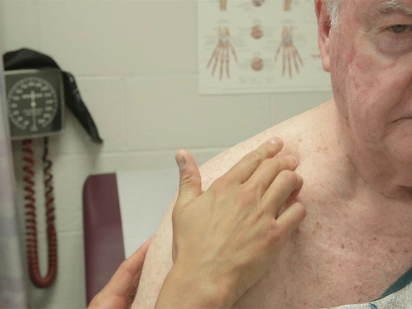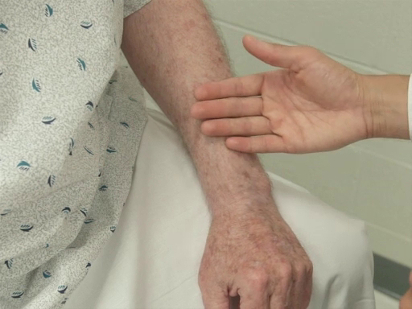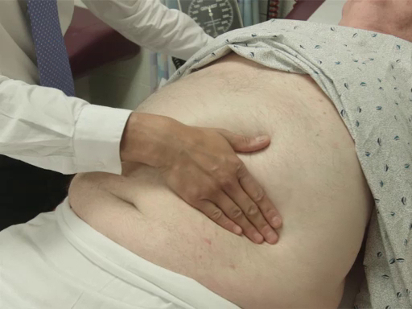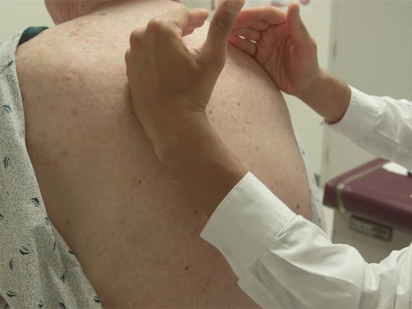Palpazione
Panoramica
Fonte: Jaideep S. Talwalkar,MD, Medicina interna e pediatria, Yale School of Medicine, New Haven, CT
L'esame fisico richiede l'uso di tutti i sensi del fornitore per ottenere informazioni sul paziente. Il senso del tatto viene utilizzato per ottenere informazioni diagnostiche attraverso la palpazione.
Le parti specifiche della mano dell'esaminatore utilizzate per la palpazione differiscono in base alla parte del corpo esaminata. A causa della loro densa innervazione sensoriale, i cuscinetti delle dita sono utili per la discriminazione fine(ad esempio,definendo i confini delle masse, dei linfonodi) (Figura 1). La superficie dorsale della mano fornisce un senso approssimativo della temperatura relativa (Figura 2). Le superfici palmari delle dita e delle mani sono più utili per il rilevamento di ampie aree del corpo(ad esempio,addome) (Figura 3). La vibrazione è meglio apprezzata con la superficie ulnare delle mani e del5 ° dito(ad esempio,il fremito tattile) (Figura 4).
Mentre la palpazione è fondamentale per l'aspetto diagnostico dell'esame fisico, è anche importante riconoscere il ruolo che il tatto gioca nel comunicare cura e comfort durante l'incontro con il paziente. I pazienti generalmente percepiscono il contatto da un operatore sanitario in una luce positiva e le loro percezioni di un operatore sanitario possono essere modellate dall'uso esperto del tatto durante gli incontri clinici. 1 Il contatto fisico è stato associato ad alterazioni dei livelli ormonali e dei neurotrasmettitori, in particolare diminuzioni del cortisolo e aumenti della serotonina. 2
Pertanto, attraverso l'uso attento della palpazione, e del tatto in generale, durante l'esame fisico, il clinico ha l'opportunità di acquisire importanti informazioni diagnostiche, sviluppando al contempo il rapporto e promuovendo la guarigione.

Figura 1. Esame dei linfonodi con cuscinetti per le dita.

Figura 2. Usando il dorso della mano per valutare il calore.

Figura 3. Palpazione addominale con superficie palmare delle dita e delle mani.

Figura 4. Usando la superficie ulnare della mano per valutare il fremitus tattile.
Procedura
1. Prima dell'incontro con il paziente
- Mantieni le unghie pulite, curate e tagliate.
- Lavarsi le mani con acqua e sapone o soluzione disinfettante topica.
- Riscaldare le mani come possibile(ad esempio,con acqua tiepida o strofinandole insieme) prima del contatto con il paziente.
- Se sono necessarie specifiche precauzioni per il controllo delle infezioni per l'incontro clinico(ad esempio,precauzioni di contatto), spiegare al paziente perché si indossano dispos
Applicazione e Riepilogo
Questa dimostrazione ha riguardato le considerazioni generali relative alla palpazione durante l'esame fisico. Mentre le tecniche specifiche variano in base a ogni singola parte dell'esame, molti principi generali relativi alla palpazione si mantengono per tutto l'esame. L'attenzione alla sicurezza e al comfort del paziente si ottiene attraverso il lavaggio delle mani, una corretta toelettatura, il riscaldamento delle mani, le precauzioni per il controllo delle infezioni e il drappeggio sensibile. La parte corretta delle
Riferimenti
- McCann, K., McKenna, H.P. An examination of touch between nurses and elderly patients in a continuing care setting in Northern Ireland. Journal of Advanced Nursing. 18, 838-46 (1993).
- Field, T. Violence and touch deprivation in adolescents. Adolescence. 37 (148), 735-749 (2002).
- Verrees, M. Touch me. JAMA. 276 (16), 1285-1286 (1996).
Vai a...
Video da questa raccolta:

Now Playing
Palpazione
Physical Examinations I
84.6K Visualizzazioni

Approccio generale all'esame obiettivo
Physical Examinations I
117.6K Visualizzazioni

Osservazione e ispezione
Physical Examinations I
95.1K Visualizzazioni

Percussione
Physical Examinations I
101.8K Visualizzazioni

Auscultazione
Physical Examinations I
62.3K Visualizzazioni

Adeguamento corretto dell'abbigliamento del paziente durante l'esame obiettivo
Physical Examinations I
83.5K Visualizzazioni

Misurazione della pressione sanguigna
Physical Examinations I
108.9K Visualizzazioni

Misurazione dei segni vitali
Physical Examinations I
115.0K Visualizzazioni

Esame obiettivo dell'apparato respiratorio I: ispezione e palpazione
Physical Examinations I
157.5K Visualizzazioni

Esame obiettivo dell'apparato respiratorio I: percussione e auscultazione
Physical Examinations I
213.1K Visualizzazioni

Esame obiettivo del cuore I: ispezione e palpazione
Physical Examinations I
176.7K Visualizzazioni

Esame obiettivo del cuore II: auscultazione
Physical Examinations I
140.1K Visualizzazioni

Esame obiettivo del cuore III: suoni cardiaci anormali
Physical Examinations I
91.9K Visualizzazioni

Esame obiettivo della vascolatura periferica
Physical Examinations I
68.8K Visualizzazioni

Esame vascolare periferico utilizzando un Doppler a onda continua
Physical Examinations I
38.6K Visualizzazioni